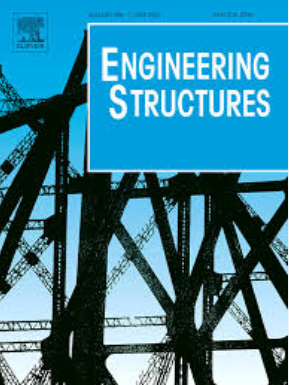大型木结构体系轴压作用下交叉层合材长期蠕变特性试验研究
IF 5.6
1区 工程技术
Q1 ENGINEERING, CIVIL
引用次数: 0
摘要
了解交叉层压木材(CLT)的蠕变行为是评估CLT结构体系(如后张拉CLT剪力墙结构)长期性能的基础。本研究对CLT材料试件进行短期抗压试验,获得其抗压强度。然后,对10个CLT块体亚组进行了长期蠕变试验,获得了轴压下CLT块体的蠕变行为。在330天的时间里,连续监测环境温度和相对湿度、含水率、环境应变和CLT试件蠕变应变。分析了相对湿度和含水率的变化规律,计算了与CLT含水率相关的参数。对于受面内和面外压缩的CLT,分别计算了环境变形系数和蠕变系数。分析了应力水平、截面几何形状和层数对CLT蠕变行为的影响。采用正态回归和加权非线性回归方法对常用的木材蠕变模型进行了校正,并利用校正后的模型估算了CLT在50年使用寿命内的蠕变系数。结果表明,CLT沿其面外方向的横向环境应变显著高于其主强度方向的面内环境应变。当受到持续的恒定应力时,具有较小截面几何形状的CLT易于产生较大的蠕变。此外,与3层CLT相比,5层CLT更容易沿其面内主强度方向发生力学吸附蠕变。对于5层100 mm厚度的CLT地板,其50年蠕变系数在6.00 ~ 7.70之间。3层105 mm厚CLT墙板和5层175 mm厚CLT墙板的50年蠕变系数分别为1.19和1.42。本文章由计算机程序翻译,如有差异,请以英文原文为准。
Experimental study on the long-term creep behavior of cross-laminated timber under axial compression used for mass timber structural systems
Comprehending the creep behavior of cross-laminated timber (CLT) is the basis for evaluating the long-term performance of CLT structural systems (e.g., post-tensioned CLT shear wall structures). In the study, short-term compressive tests were conducted on CLT material specimens to obtain their compressive strength. Then, long-term creep tests were conducted on 10 subgroups of CLT blocks to obtain their creep behavior under axial compression. Ambient temperature and relative humidity, as well as moisture content, environmental strain and the creep strain within the CLT specimens were monitored continuously over 330 days. The variations of both the relative humidity and the moisture content were analyzed, and the parameters related to the moisture content of CLT were calculated. For the CLT subjected to in-plane and out-of-plane compression, both the coefficient of environmental deformation and the creep coefficient were calculated. The effects of the stress levels, the section geometry, and the number of CLT layers on the CLT creep behavior were analyzed. The common creep models of timber were calibrated by using the normal and the weighted nonlinear regression methods, and the creep coefficients of CLT over the 50-year service life were estimated by using the calibrated models. It is found the transverse environmental strain of CLT along its out-of-plane direction is significantly higher than the in-plane environmental strain of CLT along its major strength direction. When subjected to a sustained constant stress, the CLT with a less section geometry is prone to larger creep deformation. Besides, compared to the 3-layer CLT, the 5-layer CLT is more prone to the mechano-sorptive creep along its in-plane major strength direction. For the 5-layer 100-mm-thickness CLT floors, their creep coefficient over 50 years ranges from 6.00 to 7.70. By contrast, for the 3-layer 105-mm-thickness CLT wall panels and 5-layer 175-mm-thickness CLT wall panels, their creep coefficients over 50 years are suggested as 1.19 and 1.42, respectively.
求助全文
通过发布文献求助,成功后即可免费获取论文全文。
去求助
来源期刊

Engineering Structures
工程技术-工程:土木
CiteScore
10.20
自引率
14.50%
发文量
1385
审稿时长
67 days
期刊介绍:
Engineering Structures provides a forum for a broad blend of scientific and technical papers to reflect the evolving needs of the structural engineering and structural mechanics communities. Particularly welcome are contributions dealing with applications of structural engineering and mechanics principles in all areas of technology. The journal aspires to a broad and integrated coverage of the effects of dynamic loadings and of the modelling techniques whereby the structural response to these loadings may be computed.
The scope of Engineering Structures encompasses, but is not restricted to, the following areas: infrastructure engineering; earthquake engineering; structure-fluid-soil interaction; wind engineering; fire engineering; blast engineering; structural reliability/stability; life assessment/integrity; structural health monitoring; multi-hazard engineering; structural dynamics; optimization; expert systems; experimental modelling; performance-based design; multiscale analysis; value engineering.
Topics of interest include: tall buildings; innovative structures; environmentally responsive structures; bridges; stadiums; commercial and public buildings; transmission towers; television and telecommunication masts; foldable structures; cooling towers; plates and shells; suspension structures; protective structures; smart structures; nuclear reactors; dams; pressure vessels; pipelines; tunnels.
Engineering Structures also publishes review articles, short communications and discussions, book reviews, and a diary on international events related to any aspect of structural engineering.
 求助内容:
求助内容: 应助结果提醒方式:
应助结果提醒方式:


